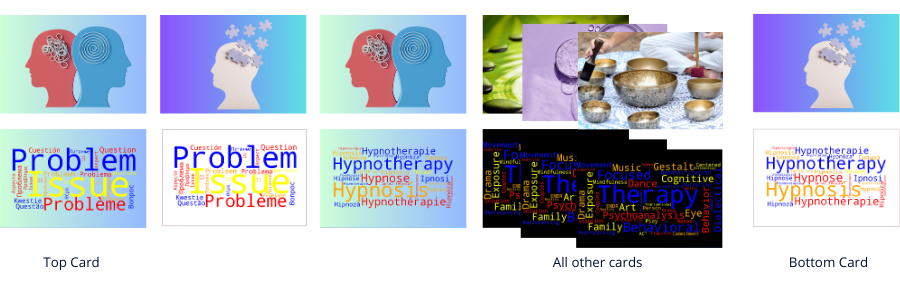
Rainbow Therapy Cards Manual
Introduction
The Rainbow Therapy Cards are an enchanting adaptation of the classic Rainbow Deck card trick, crafted to introduce participants to the rich world of therapy and hypnosis. This unique version replaces traditional playing cards with Therapy Cards, each featuring various types of therapies and symbolic imagery that guide participants through a surprising and insightful experience. Combining magic with introspection, the Rainbow Therapy Cards help participants discover connections that mirror the therapeutic journey, fostering personal insight and awareness.
This manual provides a step-by-step guide on how to perform the Rainbow Therapy Cards effect, ensuring your audience experiences a profound sense of wonder. Through this magical experience, participants can find unexpected connections between their challenges and hypnotherapy as a potential solution.
What's in the package?
A specially prepared deck of Rainbow Therapy Cards, where:
- The backs of the cards depict different types of therapy (e.g., art therapy, cognitive behavioral therapy, sound therapy), each with a unique image.
- The fronts of the two initial cards feature the words “Issue” and “Problem” written in various languages.
- Two other cards in the deck feature words like “Hypnotherapy” and “Hypnosis” in different languages.
Preparation
Arrange the deck in advance to set up the desired effect. Ensure that:
- The “Issue” and “Problem” Cards are positioned at the top for easy access.
- The blue “Hypnotherapy” Card is placed immediately after the “Issue” and “Problem” Cards.
- The white “Hypnotherapy” Card is positioned at the bottom of the deck.
- The remaining cards in the deck display “Therapy” in black, to create the final reveal.
Familiarize yourself with the deck, and practice handling it smoothly, as the effect relies on a natural and confident presentation.

Performance Instructions
Introduction: Start by showing the Therapy Cards to your audience. Mention that these cards were discovered in a search for unique ways to visualize different types of therapy. Explain that each card’s back displays a distinct therapy, giving the deck a special quality.
The First Selection:
- This segment is most effective with two spectators. Show them the two “Issue/Problem” Cards, explaining that everyone faces different challenges, and these cards represent such personal struggles.
- Hand one “Issue/Problem” Card with a white background to one spectator, and the other “Issue/Problem” Card with a blue background to the second spectator. Invite each to think of a personal issue or problem they’d like to resolve (they don’t have to share it aloud).
- Begin dealing the cards face-down onto the table. Ask each spectator to say “stop” whenever they feel ready, allowing them to choose where their specific card will go in the deck.
- Start with the spectator holding the white “Issue/Problem” Card, which corresponds with the white “Hypnotherapy” Card at the bottom. Place the “Issue/Problem” Card face up at the chosen spot, and then place the remaining stack of cards on top of it.
The Second Selection:
- Resume dealing the cards and ask the second spectator to say “stop” whenever they feel ready.
- When they say “stop,” place the blue “Issue/Problem” Card face up, marking the second spot, and then place the remaining stack of cards on top of it.
The Reveal:
- Spread the cards on the table, drawing attention to the two face-up “Issue/Problem” Cards and the cards that are directly next to them. Emphasize that the spectators could have stopped at any point, making this outcome appear entirely random and guided by their intuition.
- Carefully remove each face-up “Issue/Problem” Card along with the card directly on top of it, and set these pairs aside together. This will keep the focus on the selected cards as you prepare for the next reveal.
The Back Match:
- Point out that the backs of the two selected “Hypnotherapy” Cards match perfectly, whereas all other cards display various types of therapies. This coincidence reinforces the idea that the spectators were led to a suitable form of therapy.
The Final Reveal:
- For the finale, turn over the remaining cards to show that they all display “Therapy” in black. Note that, among many therapy types, the right answer sometimes appears at the perfect moment—just as hypnotherapy did in this demonstration.
Conclusion
Close by thanking the spectators and noting that therapy, like magic, often brings unexpected yet meaningful connections. Remind them that while challenges may seem overwhelming, the right solution can emerge when least expected. Encourage participants to consider the underlying message: exploring different forms of therapy can lead to profound, positive changes.
Tips for Effective Performance
- Emphasize Free Choice: Ensure spectators feel fully in control of their choices to enhance the sense of magic and serendipity.
- Engage with the Audience: Use gentle humor and a warm tone to make spectators comfortable, creating a conversational and relaxed atmosphere.
- Use Misdirection: Engage in light conversation or point out card details to subtly draw attention away from the deck’s setup.
Credits
The original Rainbow Deck concept was developed by Nick Trost. This adaptation was crafted to incorporate therapeutic themes, encouraging self-reflection and highlighting the potential of hypnotherapy and other therapeutic modalities.

